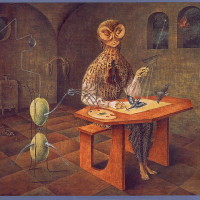As Mother’s Day 2015 approaches, I feel called to write about a subject I’ve lived intimately, a subject I’ve explored in The Conditions of Love and is now shaping my new novel Digging To China—the conflict many women feel between their creative and domestic selves.
Mother. Writer. Are these dueling destinies? How much do the roles oppose? Do the separate roles fracture our identities? How permeable or dense is the membrane between them? Mother. Writer. Where can we find the energy, the juju, the concentration, the tremendous love, care, and devotion needed in equal measures in both domains? Do you know what I’m talking about? I think you do!
Here’s what I can tell you about my own experience: I struggled. And I still struggle with finding a balance between putting myself into my written work and into relationships.
I love these two poems for their recognition of the split between the “milk-giver” and “the moon-ridden girl.”
Muriel Rukeyser
In Mind
Denise Levertov
Even before I took up writing professionally, I was jolted awake by the voices of certain poets, women poets who were shoving open the windows of their houses and shouting in wrath and fury, despair and righteousness, about their lives.
The essay that I read and reread dozens of times, that spoke to me so directly I was astonished anyone could know so much about my life was Adrienne Rich’s When We Dead Awaken: Writing As Re-Vision. Her words startled me into recognition of my own guilt, my own confusion and isolation.
She writes:
…I was also determined to prove that as a woman poet I could also have what was then defined as a “full” woman’s life, I plunged in my early twenties into marriage and had three children before I was thirty…I went on trying to write: my second book and first child appeared in the same month…If there were doubts, if there were periods of null depression or active despairing, these could only mean that I was ungrateful, insatiable, perhaps a monster…about the time my third child was born, I felt that I had either to consider myself a failed woman and a failed poet, or to try to find some synthesis by which to understand what was happening to me.
To feel oneself a monster…to suffer this in silence…to be at odds with one’s deepest desires…and to be isolated in one’s suffering—do these conditions still exist for women writers who are raising families (and male writers who are the primary caregivers in their homes)?
 The truth is, the very attributes that contribute to a rich, deep, profound, and thrilling creative life are antithetical to sustaining a stable home. Writing, at least as I know it, thrives on the chaotic and unpredictable shifts and flashes of the imagination; it demands devotion, loyalty, ruthlessness in the face of despair, enormous amounts of energy and attention—all of which might otherwise be directed toward one’s beloveds.
The truth is, the very attributes that contribute to a rich, deep, profound, and thrilling creative life are antithetical to sustaining a stable home. Writing, at least as I know it, thrives on the chaotic and unpredictable shifts and flashes of the imagination; it demands devotion, loyalty, ruthlessness in the face of despair, enormous amounts of energy and attention—all of which might otherwise be directed toward one’s beloveds.
Rich says:
But to write poetry or fiction, or even to think well…a certain freedom of mind is needed—freedom to press on; to enter the currents of your thoughts like a glider pilot, knowing that your motion can be sustained, that the buoyancy of your attention will not suddenly be snatched away… To be maternally with small children all day in the old way, to be with a man in the old way of marriage, requires a holding-back, a putting-aside of that imaginative activity and demands instead a kind of conservatism…
Your attention suddenly snatched away. Split loyalties. The soccer game, the swim team, the poem, the essay: they all shouted at once, a confused and confusing cacophony that sent me hurrying in ten different directions.
But like Rich, I felt rise up in me an unquenchable desire to speak the truth about things unsaid and unspoken. I housed a hunger I hadn’t let myself feel until I heard the words of other women writers describing, most desperately, their hunger to have a voice. This is what we can do for each other: mirror, echo, witness, model.
 Over time, I’ve come to adopt a different perspective, one that expands the view of what we are doing when we continue to embrace the warring imperatives of our souls—what the Jungians call holding the tension of the opposites. By creating a literal home we build a place to contain and house all our parts. This place/space holds our love, our security, grounds and shelters us against storms and unpredictable weather—I mean the turbulence inherent in a creative life. We need our homes just as our homes need us; we need a place where the offspring of our imaginations can grow and thrive.
Over time, I’ve come to adopt a different perspective, one that expands the view of what we are doing when we continue to embrace the warring imperatives of our souls—what the Jungians call holding the tension of the opposites. By creating a literal home we build a place to contain and house all our parts. This place/space holds our love, our security, grounds and shelters us against storms and unpredictable weather—I mean the turbulence inherent in a creative life. We need our homes just as our homes need us; we need a place where the offspring of our imaginations can grow and thrive.
Terry Tempest Williams writes with great eloquence about women’s voices and women’s silences in her poignant memoir, When Women Were Birds, an ode to her mother who died of cancer at 54. Her mother had bequeathed the author her journals—all of them blank inside. Williams writes:
She left me her “Cartographies of Silence.” I will never know her story. I will never know what she was trying to tell me by telling me nothing. But I can imagine.
 After reading When Women Were Birds, it struck me that I did not know my own daughters’ experiences of what it was like growing up with a mother who also happened to be a writer. So I asked them each if they would write a few words for this blog.
After reading When Women Were Birds, it struck me that I did not know my own daughters’ experiences of what it was like growing up with a mother who also happened to be a writer. So I asked them each if they would write a few words for this blog.
Jennifer:
- I recall falling asleep to the click, click, click….. zing… of the typewriter in the room next door. There was something rhythmic and reassuring about it.
- I grew up with poetry infused into everyday life in a way that most don’t. It was not uncommon to have you recite a poem (not necessarily yours; often not) in what seemed like random moments. Before meals… at gatherings… And to this day, I think I’ve picked up this propensity. I’m often quoting/reciting poems or openings to books… quotes… at random moments. I reference you whenever I do this with new people. I just say “I grew up in a house with a writer.”
- Honestly… there were books everywhere in our house. Before the bookshelves were built in the living room and sunroom, there were piles of books everywhere.
- You have this incredible and unique capacity to offer exactly the right “text” to someone (including me) at precisely the right moment. Did then, still do.
- I have poetry books you gave me as a kid (kid versions) that I still have poems memorized from (e.g., “Who has seen the wind…” or “Jenny kissed me when we met…”)
- You seemed to struggle then (and still do) with trying to find a balance between being in your writing space and in normal everyday space. When we were growing up, your writing space seemed to be more around the margins of your life with us (after hours… when we were at school). Now it is pretty central. But I think there is still the tension of how to immerse and be present with your writing and not disappear forever. Not that you’d want to. . . but it seems the structure of when to go in and then pull out was more defined by us and your wanting to be present with us.
Jessica: Growing up with a mom as a writer certainly set me aside from my friends. I was encouraged to learn the language of colors and moods, not of apple pie and golf. My friends did not make the acquaintance of Mary Oliver, Robert Frost, or the man at the mic bravely sharing his work at a poetry reading on campus. A world unheard of by my friends was at my fingertips. Beyond poems and prose was the way I was encouraged to view the world: ripe, aging, new, dying, tragic, humorous, raw… full of suffering and hidden miracles. I would not trade my upbringing, second daughter of an amazing writer, artist, and poet. I am lucky to have learned and lived (and still do!) the language and veil of creativity from the best, my mom.
My daughters have been kind. Hugely supportive, always. I was, at times, a “space cadet,” a distracted mom, cranky and preoccupied, sometimes gone for weeks at a time to write, but I’ve always been haunted by what Jung said: that our children live out our unlived lives. And so, isn’t it better to live our passions honestly and not drop the burden of unfulfilled desires onto our kids? We never do know when we are launched on creative projects that compel and enthrall us—raising children, writing a novel—how smooth or bumpy the road will be. But follow it we must. And if we are lucky, as I have been, our children will also reap the rewards.






